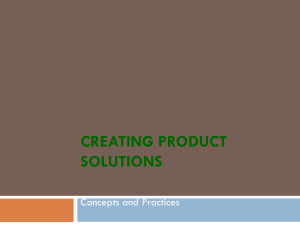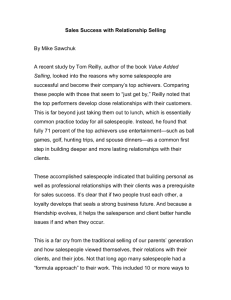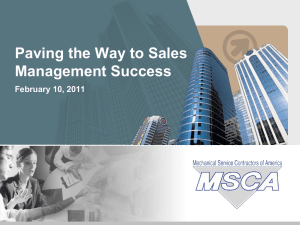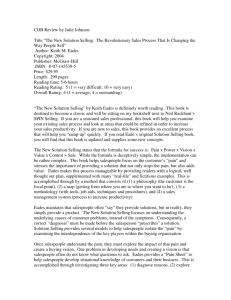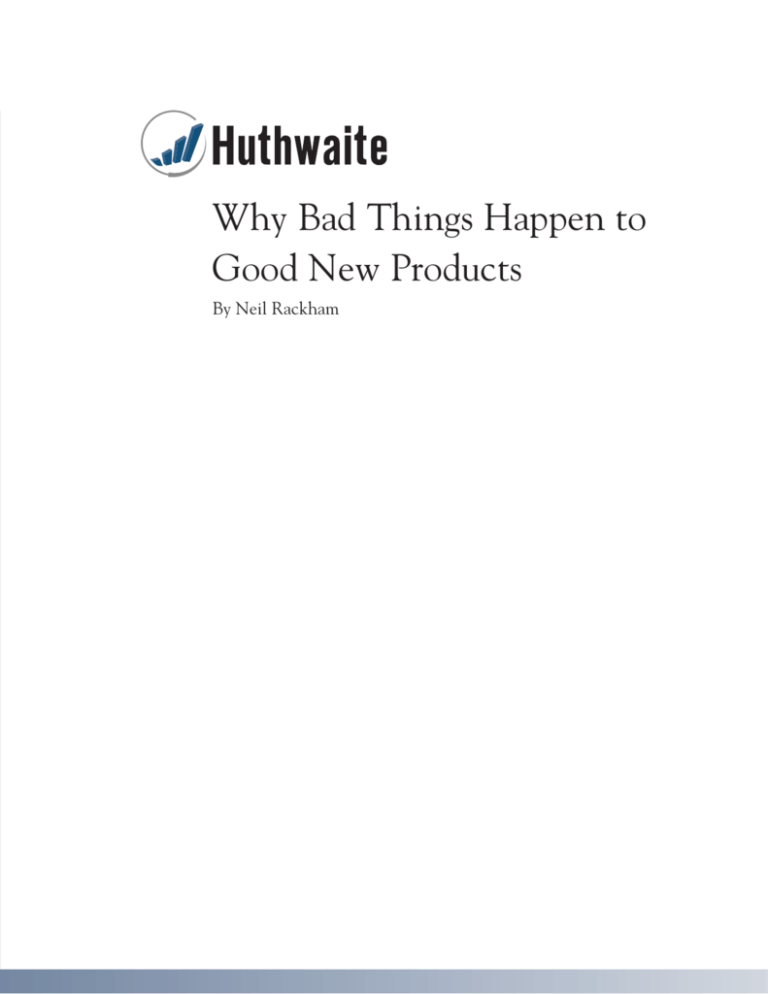
Why Bad Things Happen to
Good New Products
By Neil Rackham
Why Bad Things Happen to Good New Products
©2006 Huthwaite, Inc.
All rights reserved.
These copyrighted materials may not be reproduced, publicly displayed, or used to create derivative
products in any form without prior written permission from:
Huthwaite, Inc.
22630 Davis Drive, Suite 100
Sterling, VA 20164
703-467-3800
www.huthwaite.com
The following marks are registered trademarks of Huthwaite, Inc.:
SPIN®, Huthwaite®, SPIN Selling®, Making Major Sales®, SPA® and Strategic SPIN®.
®
at
io
Changes Ov
e
n
rT
im
e
cog
I mp
Re
lem
en
t
The following marks are trademarks of Huthwaite, Inc.:
n i t i on of Need
Decision
s
utio
Co
nc
n
s
f
no
Creating Client Value
™
Resol
™
The Buying Cycle
™
ern
s
E valuation
of
Op
tio
Why Bad Things Happen to Good New Products
Why Bad Things Happen
to Good New Products
It’s an all too familiar story. A significant new product is about to be introduced. It’s
technologically innovative, it meets a clear market need and, best of all, it leapfrogs the
competition. During the final development stages, top management becomes increasingly
convinced that this could be the make-or-break product that comes along once in a generation.
The whole company is geared for the launch. Feedback from test placements is phenomenal;
initial reviews in the trade press are little short of ecstatic. With all the customary hoopla and
hyperbole, the product is introduced to the sales force. During the next few weeks, everyone
holds their breath waiting for reaction from customers. Salespeople report great initial
enthusiasm from the marketplace and, with a sigh of relief, management begins to wonder
whether the early sales projections that seemed so ambitious before the launch should now be
revised upwards.
Then a curious thing happens. Customer enthusiasm evaporates. The expected sales don’t
materialize. Excuses give way to panic and the dark rumors begin. Maybe it isn’t such a fine
product after all; marketing hasn’t positioned it properly or the sales force is incompetent.
There are plenty of candidates to take the blame, but the fact is that nobody has a clue why a
product with such great promise seems to be struggling for its life. What is going wrong?
The product itself often becomes the first target for retribution. But the fact is that some of the
best products of our time have gone through exactly this rocky start. Take three examples of
fine innovative products whose initial sales were so slow that corporate executives were
convinced they had a major disaster on their hands:
• Xerox 9200: This was the first, and probably the most revolutionary, plain
paper, high volume copier duplicator. In addition to producing copies twice as
fast as its nearest competitor, it offered a dazzling array of bells and whistles such
as limitless sorting. Extensive focus group studies had indicated a strong market
need for such a product. Early indications from the initial launch showed high
customer interest and the launch team had every reason to feel they had a winner
©2006 Huthwaite, Inc.
1
Why Bad Things Happen to Good New Products
on their hands. I recall visiting the initial launch in Dallas where euphoria was
everywhere. Salespeople were bubbling with enthusiasm and groups of customers
attending product demonstrations were full of praise. Trade press reviews calling
the 9200 “the biggest breakthrough since Xerography itself” were pinned on every
wall. Expectations were high, confidence was even higher. Three months later,
it was a different story indeed. The expected orders weren’t coming. Salespeople
I talked to were subdued and seemed equally divided between blaming marketing
for positioning the product to compete with offset printers and blaming the
product for complexity and unnecessarily expensive features.
• Honeywell TDC 2000: The TDC 2000 was a major advance in distributed
process control automation. It allowed unprecedented flexibility in the design
and running of industrial processes just at a time when new methods and market
demands were forcing industrial plants to become much more flexible. Its
technology was good and its timing seemed perfect. Again, initial enthusiasm
was high from customers and companies alike. And again, sales were agonizingly
slow to materialize.
• Kodak Blood Analyzer: When Kodak used its color chemistry expertise to enter
the medical market with a new technology for blood analysis, it appeared to have
come up with a winner. But the all too familiar story repeated itself. The high
initial enthusiasm from all parties rapidly gave way to disappointing early sales
and general despondency.
These are not isolated examples, although they are a little unusual in that each had a happy
ending and made a miraculous recovery from near death in the marketplace just at the point
where their creators were ready to give them a decent burial. Others have been less lucky.
Disappointing initial sales is an epidemic, and sometimes fatal, childhood disease in the life of
many new products and services. There are a lot of deserving innovative products that don’t
survive into adolescence.
Some Possible Explanations
Why should promising products from highly respected companies fail despite clear evidence of
market need, strong marketing support, and real enthusiasm and energy from salespeople? It’s a
question that has puzzled generations of product managers whose meteoric rise to corporate fame
has been temporarily blocked by slow sales of their latest offerings. There’s no shortage of
opinions to account for slow sales but very little hard data to explain the cause. Two of the most
commonly held hypotheses are:
2
©2006 Huthwaite, Inc.
Why Bad Things Happen to Good New Products
Customer Resistance to Change
Most customers, so the argument goes, are intrinsically conservative and resist innovation.
Apart from the few early adopters, whose enthusiasm for new products knows no bounds, the
broad mass of customers sees innovation as risky and finds new unproven products less attractive
than tried and tested alternatives. Consequently, any innovative product, particularly if it has a
high technological component, will meet resistance and will sell slowly until it is perceived as
safe by potential customers. How plausible is this explanation in the three examples we’ve
quoted? Frankly, it just doesn’t ring true. I was associated with each of these product
introductions and my research team investigated elements of all three launches. We talked with
more than 200 potential customers and we watched their discussions with salespeople. Few of
the initial prospects for these products behaved like cautious customers timid in the face of
innovation. On the contrary, the majority were welcoming of the innovative aspects of the
products. Even more telling, their behavior was opposite that of classic resistant customers. A
resistant buyer usually begins with a high level of skepticism and becomes progressively more
accepting with repeated exposure to the product. That’s not what was happening here. During
initial exposure to the products, the majority of these customers expressed enthusiasm and
acceptance. As the sales discussions progressed, however, this enthusiasm began to fade. It was
the apparent initial acceptance of innovation that gave the product creators such hope for
success and, when customer enthusiasm evaporated, made the sales results all the more
disappointing. It became clear to us that we needed to look elsewhere for an explanation of
what was wrong.
Sales Conservatism
A second, equally plausible argument suggests that salespeople are resistant to change and are
unwilling to sell innovative products that lie outside their comfort zone. Had that been the case
here, we would have predicted that:
1. A significant proportion of salespeople would be unenthusiastic about these new
products.
2. Those who had greater enthusiasm for the products would have better sales
results than those whose enthusiasm was lower.
Neither of these predictions proved correct. Strangely enough, there was a slight negative
correlation between salespeople’s enthusiasm and sales results. That’s a surprising enough
finding to deserve repeating. We found that the salespeople with the best results showed less
enthusiasm for the new products than those whose results were mediocre. Our first thought was
that we had loaded our data backwards. Given the commonly held view that belief in the
product is essential for effective
©2006 Huthwaite, Inc.
3
Why Bad Things Happen to Good New Products
sales—especially for a new product that doesn’t have a track record to create its own belief from
customers—we were taken aback. While at first we had no way to explain this strange finding,
one thing was for sure: It didn’t seem that the poor sales could be blamed on salespeople’s
resistance to new products.
An Alternative Explanation
From watching salespeople with their customers, we became convinced that there was another
explanation for slow sales. We had developed a set of observation tools for measuring the
behavior of salespeople during calls. Using these behavior analysis tools, we found that
salespeople behaved in a fundamentally different, and less effective, way when selling new
products. First, let’s give an example of how behavior analysis observation worked in practice.
Trained researchers watched actual calls and recorded how often the buyer or seller used certain
behaviors. These observations were correlated with the outcome of the call to build a profile of
how successful calls differed from those that failed. Researchers found that a strong positive
correlation existed between the number of questions asked in sales calls and whether the calls
succeeded. Product features, on the other hand, were negatively correlated with success—
during failed calls, salespeople described more than twice as many features as they did during
calls that succeeded. A full account of the methodology and the findings from studies of 116
behaviors in 35,000 sales calls can be found in the book SPIN Selling [1].
Figure 1: How questions decrease when selling new
products. . .
Questions asked per call
30
25
24.2
20
15.8
15
10
5
0
4
Selling existing
Selling new products
products (180 calls)
(198 calls)
©2006 Huthwaite, Inc.
Compositing the data from these three product
launches, we counted the number of questions
asked by salespeople during those calls where
they were selling the new products compared
with the number of questions they asked
customers during calls when selling existing
products. Questions are highly correlated with
sales success, so calls with more questions
would be statistically more likely to succeed.
We had expected to find that the base rate of
asking questions during the sale of the new
products would be higher just because of the
nature of the sale. Each of these products was
complex and required a higher than usual
number of questions to understand the
sophisticated customer problems that each
Why Bad Things Happen to Good New Products
product was designed to solve. We were
surprised to find that the number of questions
asked when selling the new products was almost
40 percent lower than the number asked with
existing products (see Figure 1).
The average call length when selling the new
products was slightly longer than for existing
products, so if salespeople were not spending
their time asking questions, what were they
doing to occupy the call time? We found that
they were spending the time talking about
product capabilities (see Figure 2).
Figure 2: . . .and product details increase
Product feaures & advantages
20
18
16
14
12
10
8
6
4
2
0
18.3
5.9
Selling existing products
Selling new products
These results, which have since been replicated
(180 calls)
(198 calls)
in studies of several other product launches,
point to a fundamental problem in selling
innovative products. The more innovative the product, (and the richer it is in bells and
whistles), the more likely salespeople will sell it through features rather than through questions.
In other words, a powerful new product is likely to make salespeople product-centered instead of
customer-centered. There’s overwhelming evidence (Rackham, 1987 [1]; Rackham, 1988 [2];
Rackham and Wilson, 1990 [3] ) that sales calls having a high number of product features and a
low number of questions are likely to be unsuccessful. What’s more, the negative impact of
giving product capabilities becomes greater as the selling cycle progresses. So, product
capabilities can have a positive initial impact on the customer early in the sales cycle, but this
rapidly falls off as the cycle continues (see Figure 3). During the first meeting with the customer,
there is a positive correlation between the number of times salespeople describe product
advantages and whether or not the customer agrees to a future meeting. The relationship is no
longer positive by the second call on the customer. By the third call, the relationship has
become negative, so that the more salespeople “pitch the product,” the less likely the customer
will be to take actions that move the sale forward. The relationship between product
advantages and successful call outcome continues to be negative in the fourth and subsequent
calls.
All three product launches in this case started with high customer enthusiasm that rapidly
evaporated. This would be consistent with the increasingly negative impact of a productcentered approach wherein salespeople continue to “pitch the product.” At least in the case of
the three products quoted here, this provides a plausible initial explanation for the slow growth
in sales.
©2006 Huthwaite, Inc.
5
Why Bad Things Happen to Good New Products
Anecdotal Evidence
There’s another way to test the
Figure 3: How “pitching the product” becomes less effective
hypothesis that sales growth of new
products is impeded by a productcentered approach. If it’s true that
!
Positive
salespeople who are product-focused
are more likely to fail, then we would
impact on
predict that successful salespeople
the
customer of Neutral
would care less about their products
!
statements
and more about their customers. In
about
products
turn, this would cause them to be less
!
excited over the new products. As
!
we saw earlier, we found that the
Negative
salespeople with the best results
1st
2nd
3rd
4th + subsequent
showed less enthusiasm for the new
number of meetings with the customer
products than those whose results
were poor. This would be consistent
with the hypothesis that productfocused enthusiasm damages early sales. Like many others who have experienced the launch of
innovative products, we have a wealth of anecdotes to support this view. The most successful
Xerox salesperson in the 9200 launch described the product as “only a big copier,” while his less
effective colleagues were using terms like “breakthrough” and “quantum leap.” Clearly he wasn’t
going to let the product come between himself and the needs of his customers. One of
Honeywell’s most effective salespeople told us, “The TDC 2000 is a great product, but all that
technology doesn’t mean a thing unless it helps my customers run their processes better.” Again,
the salesperson didn’t allow the new product to interfere with a customer focus. Similarly, at an
American Express product launch we attended in Acapulco, there was a tremendous excitement
among the sales force about a hot new product that was being introduced. Everyone was talking
about the product except for a couple of the most experienced and successful salespeople. One
of them told us, “It’s just another product. When the fuss dies down I’ll figure out which
customers need it”—yet another example of how highly successful people never let new products
distract them from the needs of customers. Unfortunately, most organizations have few
salespeople with such fortitude. The majority of people selling are all too easily seduced by
innovative products and they willingly fall into the “pitch the product” trap that almost killed
the three fine products we researched.
6
©2006 Huthwaite, Inc.
Why Bad Things Happen to Good New Products
Good News and Bad News
There is a crumb of comfort. Even
product-obsessed salespeople become
less enthusiastic when sales don’t
materialize and, ultimately, they will
regain interest in customers. There’s
a pattern here.
Many product
managers have described how their
launch went through a four-step
process that sounds something like
this:
1. We launched a great new
product; press, customers
and salespeople were all
enthusiastic.
2. We expected great initial
sales but they didn’t
happen.
3. We became disillusioned
and began to lose faith in
the product.
4. Inexplicably, just when
we’d started to give up,
sales began to improve.
Figure 4: The chain of communication for a new product
Product Development
1
Prepare launch
materials based
on product
capabilities and
superiorities
Marketing
Launch
product to
the sales
force
Sales Force
2
Generate excitement
about the product
3
Sales force learns
product-centered
information about
capabilities,
competitive
superiorities, etc.
4
Sales force
communicates
product to customers
in the same way it
was communicated
to them – in terms of
product capabilities
Communicate
product to
customers
Customers
Communicate the
product's "bells and
whistles"
We’ve heard this so many times that
it has become for us a generic
description of the launch steps for any innovative product. When sales don’t happen, the sales
force loses their enthusiasm, all the new bells and whistles lose their luster, the product becomes
just another product and attention swings back to customers. Salespeople stop talking and start
asking. For the first time they develop customer needs for the product and sales consequently
begin to climb. Management can’t understand why the product should start to succeed at a
point where the sales force is losing enthusiasm. Our evidence suggests that success comes
because the sales force is losing enthusiasm.
©2006 Huthwaite, Inc.
7
Why Bad Things Happen to Good New Products
In post-mortem sessions, people talk about the long learning curve for selling new products as
though this painfully slow start is inevitable. As David Montanaro of NEC told us, “The secret
is to have deep enough pockets to ride out the learning curve until your sales force finally gets up
to speed. It usually takes longer than you think.” For smaller companies, who may be betting
their future on a single innovative product, the luxury of waiting for the sales force to learn isn’t
a realistic option. Even for larger and richer companies, especially those in fast-moving and
competitive markets, precious competitive lead time can be frittered away while the sales force
comes to terms with how to sell the product. There has to be a better way.
The good news is that neither the product focus, nor the long learning curve that results from it,
is inevitable. It’s relatively easy to bring about a dramatic acceleration in sales force learning
and to achieve much faster early sales results. The remedy lies in a better understanding of the
cause. Why should sales forces, heavily trained to sell through questions, suddenly abandon
their training and inundate customers with product details? The reason is simple: Salespeople
communicate product capabilities and details to customers because that’s exactly how the
product has been communicated to them. Figure 4 illustrates the typical process used by most
organizations for communicating a new product to their sales force and, through them, to their
customers.
We Have Seen the Enemy and He Is Us
Most product launch events, with their associated collateral materials, focus exclusively on
product capabilities. They explain how this product is different and better; they lovingly dwell
on each new bell and whistle. The launch is designed to sound exciting. Some very smart
people put long hours into preparing a great product pitch. So it’s small wonder that the sales
force is impressed and behaves in exactly the same way when they go out to talk with customers.
How the product was communicated to them serves as their model when they communicate
with their customers. The trouble is that customers have only a transitory interest in product
capabilities. Unless the product solves a problem, or unless it meets a need, then there’s no basis
for a sale. It takes skillful selling, based on questioning, to uncover problems, to develop needs
and link those needs to the new product. As we’ve seen from the way questions decrease and
features increase when selling new products, salespeople often fail to develop adequate needs
and the sales cycle flounders.
Product managers have only themselves to blame. The enemy, unfortunately, is us. I recall
working with a major telecommunications company, helping develop better questioning skills in
their salespeople. The fundamental message we gave salespeople—not at all unlike the message
taught to most successful business-to-business sales forces—was to sell through questions. “Don’t
8
©2006 Huthwaite, Inc.
Why Bad Things Happen to Good New Products
focus on product capabilities,” we urged them. “Research shows that if you do, you’ll lose sales.”
The following month, the company launched an innovative new product at its national sales
meeting. I cringed in the audience as capability after capability was described and the launch
manager gave just the kind of product pitch that we had been training her salespeople to avoid.
We weren’t surprised when initial sales were slower than expected.
A Better Mousetrap
There’s a simple acid test of the proposition that the way products are launched is to blame for
slow initial sales. If this is true, then by altering the way products are introduced to the sales
force, we should be able to positively influence early sales. We had an opportunity to put this to
a practical test. When the early results from Kodak’s pilot region Blood Analyzer launch looked
unpromising, we were invited to experiment with a different way of introducing the product.
We took a group of 12 randomly chosen salespeople from the Mid-Atlantic Region who had not
been exposed to the new product. We designed for them an alternative product launch that was
very different from the capabilities-based launch that was used with the rest of the organization.
Essentially, our launch consisted of the following steps:
• We told salespeople how the product solved different problems for various types
of customers, such as doctors, clinicians, medical technicians and administrators.
However, we did not describe the product’s bells and whistles, warning that these
product capabilities could easily get in the way of effective selling. To dramatize
our point, we covered the demonstration analyzer with a tarpaulin so that the
salespeople couldn’t see it.
• We took each customer type and looked in detail at the work problems they were
facing and how the new product could help solve or reduce each of these
problems.
• We asked salespeople to identify which of their existing or potential customers
had these problems that the product was designed to solve.
• Salespeople then listed the questions they could ask to discover whether these
problems existed and how severely the problems were affecting that customer.
• Each salesperson then chose a customer whose problems were particularly severe
and practiced role-playing a call on that customer. They were coached to sell
using questions that developed problems and needs, avoiding discussion of the
product’s capabilities.
• Finally, each salesperson planned three customer calls for selling the new product.
Each call plan was based on the questions that the salesperson intended to ask.
©2006 Huthwaite, Inc.
9
Why Bad Things Happen to Good New Products
We hoped that by introducing the
Blood Analyzer in this way,
salespeople would be more effective
in the early stages of the new product
sales cycle. We tracked their progress
for a year, comparing their
performance with a control group
chosen from the sales force who had
gone through the standard “bells and
whistles” product introduction. We
found that the dollar sales volume
generated by our new-style launch
group was 54 percent higher than the
control group. This was convincing
enough evidence for us to create a
template for introducing new
products to a sales force (see Figure 5).
Figure 5: Template for introducing a new product to the
sales force
Prepare product
descriptions in terms
of the problems the
product solves for key
customer
Introduce product to
salespeople in terms
of its problem-solving
capacities
1
Prepare problemcentered launch
collateral
2
Communicate in
problem-solving
terms, not "bells
and whistles"
3
Sales people list
actual and potential
customers who are
likely to have the
problems that have
been identified
Identify target
customers
Plan a call in terms
of questions to
Several companies have used this
uncover problems
template to help them introduce
and needs, not in
Plan call to target
terms of product
innovative products to their sales
customer
capabilities
forces. Canon used it to launch the
CLC 300 color copier as an
Dry-run the plan
alternative to the usual capabilitiesusing role plays
Role-play and test
based introduction.
Microsoft
and discussions
the call plan
introduced Office to their sales force
at a national sales meeting using a
Plan a call for each
version of this template. During the
strategically
important customer
Plan calls to other
meeting, everyone, including Bill
type who may have
key customer
Gates, planned sales calls to uncover
unique problems the
segments and types
product can solve
corporate problems that the Office
suite of products could solve. By the
end of the meeting salespeople had
planned and practiced more than 1,000 sales calls. Unfortunately, lack of control groups in each
case made it impossible to measure the impact of this new method. Nobody wanted to be left
out of the main launch just to provide us with validation. Although we can’t show definitive
results from these two examples, we believe there is a good case to be made that launching
products using this method constitutes a proverbially better mousetrap. It communicates the
product in a way that helps sell it and speeds the learning curve along in the process. As one of
the Kodak people told us, “This is the first time I’ve come away from a product introduction
with a clear idea of how I’m going to sell it.”
4
5
6
10
©2006 Huthwaite, Inc.
Why Bad Things Happen to Good New Products
References
1. Rackham, Neil. SPIN Selling. (New York: McGraw-Hill, 1987).
2. Rackham, Neil. Major Account Sales Strategy. (New York: McGraw-Hill, 1988).
3. Rackham, Neil and Wilson, John, “Sales Training in the 90’s,” Journal of the
American Society for Training and Development 44(2):48-52 (August 1990).
©2006 Huthwaite, Inc.
11
*2100-M00013/1*
2100-M00013
v.04


